Leonids 2006: prediction of activity
to the list of predictions
Leonid prediction for years 1901-2100
Introduction
Leonids are a meteor shower known for its variable activity. The years around parent comet 55P Tempel-Tuttle returns gave considerable activity enhancements, sometimes up to stormy levels. The latest perihelion of 55P was in 1998 and now it is moving to the outer areas of Solar system - its aphelion lies behind the orbit of Saturn. Significant enhancements in Leonid activity were recorded during the period 1994-2003. In 1999, 2001 and 2002 the shower gave several storms, when ZHR reached 3000-4000 (ZHR - zenithal hourly rate - the average number of shower meteors an observer can see during one hour when its radiant is directly overhead and stars to 6.5 mag. are visible). In 2003 and 2004 activity was slightly above the background level with ZHRs of 60 and 28 respectively (background activity is peculiar to Leonids in its "quiet" years, it usually reaches ZHR=10-20).
All main peaks of Leonid activity are traced with the modelling very good (but there are some exceptions, first of all, the 1985 case). Particles ejected by the comet form lengthy trails. One of the reasons is radiation pressure force, which acts parallel with gravitational forces. Gravitational force is dependent on a particle mass, i.e. it is proportional to the third power of particle radius. The outcrying radiation pressuse is defined by the second power of particle radius. So far the influence of radiation pressure is the more the less is size of a particle. Its action is equivalent to the diminishing of gravitational constant G. So it increases the orbital period of particles, and the tinier a particle is, the more it is continuously retarded from larger particles after their ejection be the comet. This process therefore leads to the formation of lengthy comet trails.
Meteor modelling is done through computation of orbital evolution of particles ejected by the comet with different velocities in directions tangential to the comet trajectory at the moment of perihelion. In the reality, of course, particles are ejected not only at the point of perihelion, but also within several months around it. However, comets are close to perihelion during quite a little time comparing to their overall orbital period and main perturbations happen around their aphelions, so when comets are closer to the Sun newly ejected particles are moving very close to them in a compact dust cloud. This is the reason we can take that cloud as completely ejected in the point of perihelion, it doesn't virtualy influence the results of computations.
Speaking of directions in which particles are ejected we can say that, again, in the reality they are ejected far not only in tangential directions, but in all possible ones. However, ejection velocities (from 0 to 100 m/s, and the overwhelming majority of real ejections - from 0 to 20 m/s) are negligibly small comparing to the own comet velocity (from 30 to 40 km/s) near the Earth's orbit), ejected particles have only slightly changed orbits and don't "fly away in all directions". Radial part of ejection velocity defines only thickness of a trail, which usually reaches several hundreds thousands kilometers. The shape of the trail is defined by tangential part of ejection velocity.
And the last. Non-gravitational forces are often not taken into consideration in meteor calculations, as is in our case. However, some of them, say, radiation pressure, can be considered indirectly. As far as this kind of force works as diminishing of gravitational constant G, this is equivalent to increase of ejection velocity which could be easily accounted in the model. So this non-gravitational force, as many others doesn't change the configuration of trails, but leads to shifting of particles with different masses along them.
As already mentioned, Leonid trails modelling allowed to prepare very good predictions of shower activity around the latest comet perihelion, real maximums differed from predicted ones mostly no more than on 10-15 minutes - not very much considering that computations are made for several hundreds years of particles movement. Also succesful post-predictions were done for Leonid outbursts in the past, for example, for famous storm in 1966. More serious problem is prediction of outburst intensity - how strong the maximum could be. For such predictions special empirical models were elaborated (the single way in this case) but as before for their improvment new observations are very necessary.
The results the Author obtained for the Leonids 2006 using the modelling of particles ejected by the comet 55P Tempel-Tuttle are presented below. Main characteristics of computations are also described.
Computation characteristics
I wish to introduce the first results of Leonid meteor stream simulation aimed to the prediction of shower activity in 2006. The simulation was made for the trails of latest 30 revolutions, i.e, from the 1001 trail. The Author used the program by S. Shanov and S. Dubrovsky to calculate orbital elements of ejected meteor particles. To estimate expected ZHRs for different encounters the model by E. Lyytinen and T. van Flandern given in their paper [4] was used with some Author's alterations made in order to adopt the model for ejection velocity (Vej) instead of da0 (difference in a-semimajor axis) as well as to correct fn function to consider factual Leonids activity during recent storms and outbursts. The computation considered only gravitational forces, however, the results are on the whole in good accordance with these of other researchers. The prediction includes all encounters found within interval +/-0.007 a.u. The following parts of trails were computed: the first 5 rev. trails for ejection velocities [-50;100] m/s, 6-10 rev. trails - [-30;50] m/s, 10-20 rev. trails - [-20;30], older than 20 rev. trails - [-10;20] m/s.
Results
Two non-zero encounters with Leonid trails are found for 2006. The are given in Table 1.
Table 1. Meaningful encounters between the Earth and Leonid trails in 2006.
where trail is the number of revolutions of given trail; year - the year of trail formation; rD-rE - the distance between the Earth's orbit and trail particles orbits (positive value means the descending node of trail is outside the Earth's orbit, negative - the node is inside it); Vej - velocity of particles ejection on the given trail part (positive values means the particles were ejected against the comet movement, negavive - particles were ejected along the comet movement); fM(fMD) - the characteristic of longitudinal density of the trail, it is derived from the time interval between passages of minimal distance to the Earth's orbit by particles with different ejection velocities; sol. long. - solar longitude corresponding to the maximum; Max. time - assumed time of maximum; ZHRex - ZHR expected to be produced by the trail (it should be noted, that this ZHR is "pure", i.e. it is given without consideration of background meteor activity. So far, this ZHRex value should be added to expected background activity at the time of given trail maximum to obtain the total expected level of activity
Distribution of of particles of different Leonid trails is given on Fig. 1.
Leonid prediction for years 1901-2100
Introduction
Leonids are a meteor shower known for its variable activity. The years around parent comet 55P Tempel-Tuttle returns gave considerable activity enhancements, sometimes up to stormy levels. The latest perihelion of 55P was in 1998 and now it is moving to the outer areas of Solar system - its aphelion lies behind the orbit of Saturn. Significant enhancements in Leonid activity were recorded during the period 1994-2003. In 1999, 2001 and 2002 the shower gave several storms, when ZHR reached 3000-4000 (ZHR - zenithal hourly rate - the average number of shower meteors an observer can see during one hour when its radiant is directly overhead and stars to 6.5 mag. are visible). In 2003 and 2004 activity was slightly above the background level with ZHRs of 60 and 28 respectively (background activity is peculiar to Leonids in its "quiet" years, it usually reaches ZHR=10-20).
All main peaks of Leonid activity are traced with the modelling very good (but there are some exceptions, first of all, the 1985 case). Particles ejected by the comet form lengthy trails. One of the reasons is radiation pressure force, which acts parallel with gravitational forces. Gravitational force is dependent on a particle mass, i.e. it is proportional to the third power of particle radius. The outcrying radiation pressuse is defined by the second power of particle radius. So far the influence of radiation pressure is the more the less is size of a particle. Its action is equivalent to the diminishing of gravitational constant G. So it increases the orbital period of particles, and the tinier a particle is, the more it is continuously retarded from larger particles after their ejection be the comet. This process therefore leads to the formation of lengthy comet trails.
Meteor modelling is done through computation of orbital evolution of particles ejected by the comet with different velocities in directions tangential to the comet trajectory at the moment of perihelion. In the reality, of course, particles are ejected not only at the point of perihelion, but also within several months around it. However, comets are close to perihelion during quite a little time comparing to their overall orbital period and main perturbations happen around their aphelions, so when comets are closer to the Sun newly ejected particles are moving very close to them in a compact dust cloud. This is the reason we can take that cloud as completely ejected in the point of perihelion, it doesn't virtualy influence the results of computations.
Speaking of directions in which particles are ejected we can say that, again, in the reality they are ejected far not only in tangential directions, but in all possible ones. However, ejection velocities (from 0 to 100 m/s, and the overwhelming majority of real ejections - from 0 to 20 m/s) are negligibly small comparing to the own comet velocity (from 30 to 40 km/s) near the Earth's orbit), ejected particles have only slightly changed orbits and don't "fly away in all directions". Radial part of ejection velocity defines only thickness of a trail, which usually reaches several hundreds thousands kilometers. The shape of the trail is defined by tangential part of ejection velocity.
And the last. Non-gravitational forces are often not taken into consideration in meteor calculations, as is in our case. However, some of them, say, radiation pressure, can be considered indirectly. As far as this kind of force works as diminishing of gravitational constant G, this is equivalent to increase of ejection velocity which could be easily accounted in the model. So this non-gravitational force, as many others doesn't change the configuration of trails, but leads to shifting of particles with different masses along them.
As already mentioned, Leonid trails modelling allowed to prepare very good predictions of shower activity around the latest comet perihelion, real maximums differed from predicted ones mostly no more than on 10-15 minutes - not very much considering that computations are made for several hundreds years of particles movement. Also succesful post-predictions were done for Leonid outbursts in the past, for example, for famous storm in 1966. More serious problem is prediction of outburst intensity - how strong the maximum could be. For such predictions special empirical models were elaborated (the single way in this case) but as before for their improvment new observations are very necessary.
The results the Author obtained for the Leonids 2006 using the modelling of particles ejected by the comet 55P Tempel-Tuttle are presented below. Main characteristics of computations are also described.
Computation characteristics
I wish to introduce the first results of Leonid meteor stream simulation aimed to the prediction of shower activity in 2006. The simulation was made for the trails of latest 30 revolutions, i.e, from the 1001 trail. The Author used the program by S. Shanov and S. Dubrovsky to calculate orbital elements of ejected meteor particles. To estimate expected ZHRs for different encounters the model by E. Lyytinen and T. van Flandern given in their paper [4] was used with some Author's alterations made in order to adopt the model for ejection velocity (Vej) instead of da0 (difference in a-semimajor axis) as well as to correct fn function to consider factual Leonids activity during recent storms and outbursts. The computation considered only gravitational forces, however, the results are on the whole in good accordance with these of other researchers. The prediction includes all encounters found within interval +/-0.007 a.u. The following parts of trails were computed: the first 5 rev. trails for ejection velocities [-50;100] m/s, 6-10 rev. trails - [-30;50] m/s, 10-20 rev. trails - [-20;30], older than 20 rev. trails - [-10;20] m/s.
Results
Two non-zero encounters with Leonid trails are found for 2006. The are given in Table 1.
Table 1. Meaningful encounters between the Earth and Leonid trails in 2006.
| trail | year | rD-rE | Vej | fM(fMD) | sol.long. | Max. time | ZHRex |
| rev. | - | m/s | - | ° | AU | UT | meteors |
| 2 | 1932 | 0.00013 | 88.25 | 0.466 | 236.620 | 19.11.2006 4:55 | 31 |
| 19 | 1366 | -0.00094 | 20.10 | 0.004 | 237.694 | 20.11.2006 6:28 | 1 |
Distribution of of particles of different Leonid trails is given on Fig. 1.
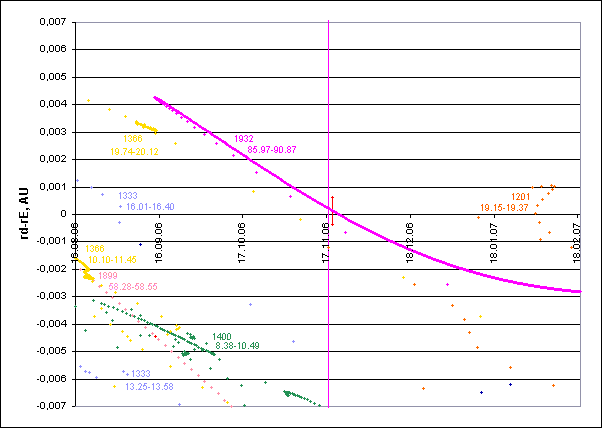
Fig. 1. Space-temporal projection of Draconid trails parts onto their minimal distance passages (for each trail the year of its formation and ejection velocities of particles, corresponding to the depicted parts of trails, are given).
The Figures 2,3,4 show different aspects of Leonid activity profile during their activity period.
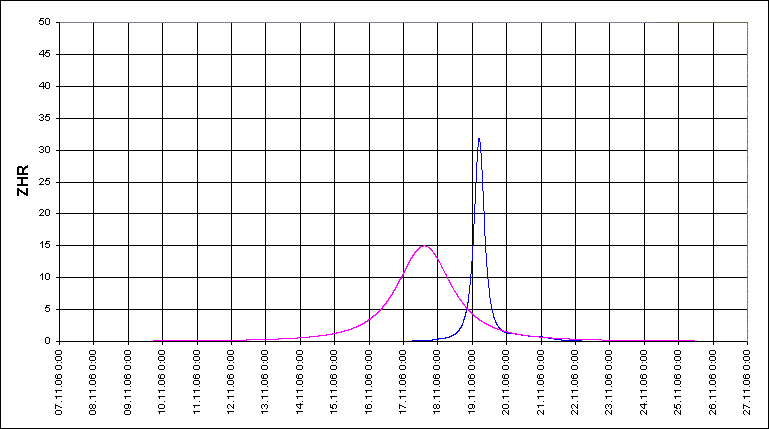
Fig. 2. The assumed profile of backgroung (the red line) and additional activity from trails (the blue line).
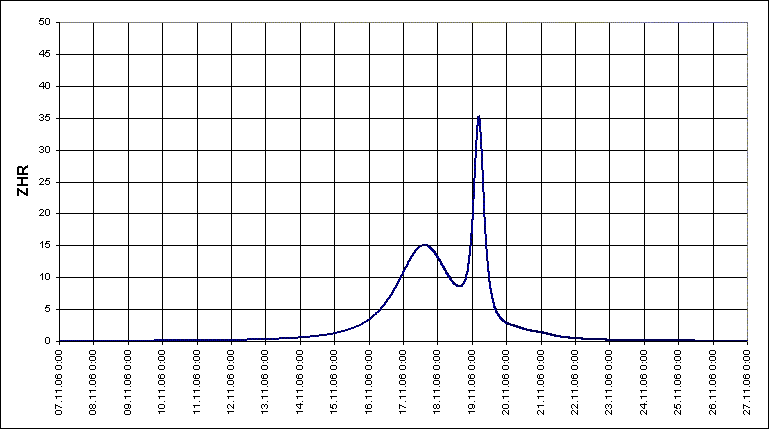
Fig. 3. The assumed profile of overall Leonid activity (from trails and background).
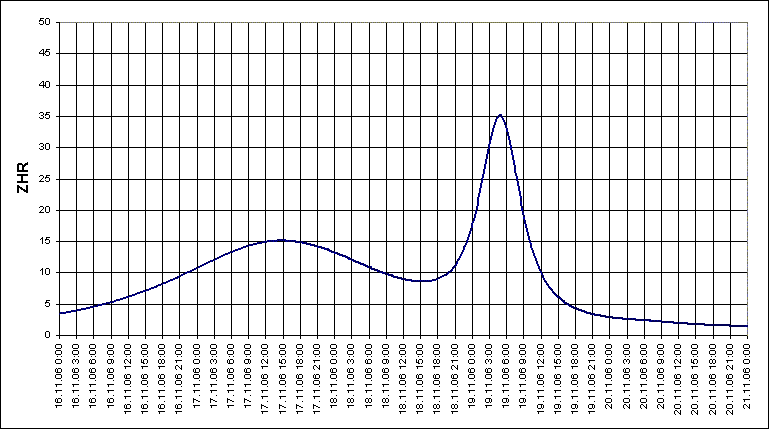
Fig. 4. Expected profile of Leonid activity around traditional maximum and outburst from 1932 trail.
We should note, that expected activity profile from trails (Fig. 2) is based on our computations, and traditional activity profile is of typical character. Also, as in 2006 major planets will pull background Leonid stream from the Earth orbit closer to the Sun, intensity of traditional maximum is expected to be low, with ZHR about 10-15 meteors. In activity profile an optimistic variant of this estimation with ZHR=15 meteors was used. The time of traditional maximum was derived from the moment of passing the minimal distance to the comet 55P orbit by the Earth (it is 17.11.2006 14:34 UT). Theoretical Leonid radiant (on the base of the parent comet orbit) at this time has coordinates RA=153.6°, Dec=+21.8°.
We also see that besides traditional maximum in 2006 a quite sufficient outburst from 1932 trail is expected. It is to occur at 4:55 UT 19 November, theoretical radiant - RA=154.3°, Dec=+21.1. Its intensity (with background) will be about 35 meteors on ZHR scale, and meteors should be very faint during the outburst. It is very possible that average meteor brightness will decrease to 4-5 mag., so for proper observations very cood conditions with transparent and not light-polluted sky are necessary. Duration of the outburst (period with activity above the half of maximum level) will be about 9 hours around mentioned maximum time. Several year ago this outburst was mentioned in the papers by D. Asher - R. MacNaught and by E. Lyytinen - T. van Flandern, though these authors gave higher estimations of maximum activity than is in our case. Their ZHRmax values are 50-100 meteors.
Much stronger activity, up to stormy levels, is likely in radiorange. It is because the Earth will pass through the part of 1932 trail consisting of very tiny particles, which will give very faint meteors, mostly beyond of visual brightness range. Therefore during this outburst telescopic and radioobservarions are very recommended.
Visibility
The figires below depict regions where traditional Leonid maximum (Fig. 5) and outburst from 1932 trail (Fig. 6) are available for observations.
We also see that besides traditional maximum in 2006 a quite sufficient outburst from 1932 trail is expected. It is to occur at 4:55 UT 19 November, theoretical radiant - RA=154.3°, Dec=+21.1. Its intensity (with background) will be about 35 meteors on ZHR scale, and meteors should be very faint during the outburst. It is very possible that average meteor brightness will decrease to 4-5 mag., so for proper observations very cood conditions with transparent and not light-polluted sky are necessary. Duration of the outburst (period with activity above the half of maximum level) will be about 9 hours around mentioned maximum time. Several year ago this outburst was mentioned in the papers by D. Asher - R. MacNaught and by E. Lyytinen - T. van Flandern, though these authors gave higher estimations of maximum activity than is in our case. Their ZHRmax values are 50-100 meteors.
Much stronger activity, up to stormy levels, is likely in radiorange. It is because the Earth will pass through the part of 1932 trail consisting of very tiny particles, which will give very faint meteors, mostly beyond of visual brightness range. Therefore during this outburst telescopic and radioobservarions are very recommended.
Visibility
The figires below depict regions where traditional Leonid maximum (Fig. 5) and outburst from 1932 trail (Fig. 6) are available for observations.
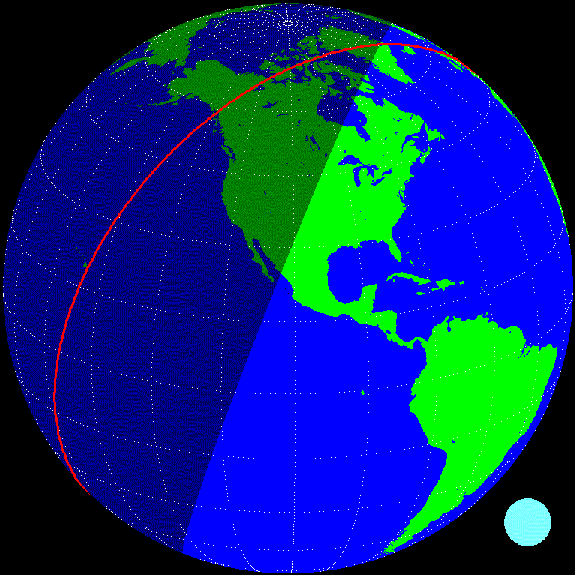
Fig. 5. The Earth as seen from coming Leonid meteors at the moment of traditional maximum at 14:34 UT 17 November. Red line shows the border of hemisphere where the Moon is above horizon (it is shown with light circle in the corner of the Fig. 5.).
At the moment of maximum the shower radiant will lie in zenith for observers on the western coast of Mexico. Visual observations of maximum are possible in the eastern Canada, north-eastern coast of the USA, Alaska, most part of Pacific ocean and (with quite low height of the radiant) Chukotski autonomous okrug of Russia. But, considering that traditional Leonid maximum is quite lengthy, observers in Northern America continent will see the period of rising activity just before the maximum, loosing very little in activity strength. Still, the situation with these observations becomes more favorable moving to the North and the West of the continent. On the other side, observers in Russian Far East and (to the lesser degree) in South-Eastern Asia will see a quite good activity on the descending branch of traditional maximum. The Moon will have a very small phase and, rising 2-3 hours before the Sun, can make a little spoiling of the morning sky.
For radioobservations, besides already mentioned regions, good conditions will form in the most part of South America, except of areas around south-eastern coast of the continent. Leonids radiant will have not very high but still good enough altitude. Nearly on the same height the radiant will lie for observers in Greenland. In Western Europe and western coast of Africa one may try to catch the period when the gradual rise of activity accelerates aiming directly to traditional maximum.
For radioobservations, besides already mentioned regions, good conditions will form in the most part of South America, except of areas around south-eastern coast of the continent. Leonids radiant will have not very high but still good enough altitude. Nearly on the same height the radiant will lie for observers in Greenland. In Western Europe and western coast of Africa one may try to catch the period when the gradual rise of activity accelerates aiming directly to traditional maximum.
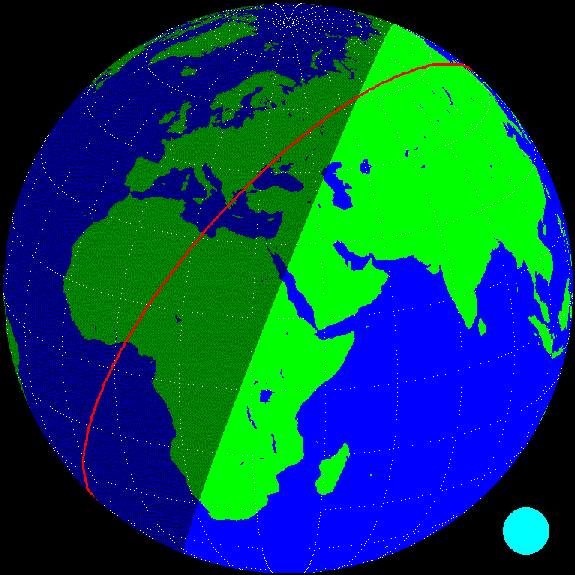
Fig. 6. The Earth as seen from coming Leonid meteors at the moment of maximum from 1932 trail at 4:55 UT 19 November. Red line shows the border of hemisphere where the Moon is above horizon (it is shown with light circle in the corner of the Fig. 6.).
At the moment of maximum the shower radiant will lie in zenith for observers on the eastern coast of the Red Sea. Visual obsrvations of maximum are possible in Eastern and Western Europe, in the part of Africa to the West of Lybia-Gabon line. On the low height the radiant will lie for observers in Greenland. The period of rising activity just before the maximum will be seen in the Russian European territory and Urals, Middle East, and all of Africa. On the other side, descending branch of activity just after the maximum will be seen in the North-East of South America and on the eastern coast of Northern America. The waning Moon crescent will rise 1-2 hours before the Sun, making mo trouble for observers.
For radioobservations excellent conditions will form on the whole African continent (besides, perhaps, the most southern areas) and on the most part of Eurasia, except of Russian Far East and South-Eastern Asia, where the radiant will have too low height. However, observers there can try to catch ascending branch of activity just before the maximum. Descending branch can be observed in radiorange generally in the same areas, as visually, - in the North-East of South America and on the eastern coast of Northern America.
Conclusions
In 2006 besides traditional maximum a suffucient outburst from 1932 trail is expected. It is to reach maximum is 4:55 UT 19 November. Its intensity will be about 35 meteors on ZHR scale, in radiorange a much stronger activity is likely, up to stormy levels. Traditional maximum is to occur at 14:34 UT 17 November, its intensity will be below normal level, with ZHR about 10-15 meteors. Waning Moon crescent can cause a little spoiling of the morning sky during traditional maximum, but by the time of 19 November outburst its influence will totally expire.
We'd like to note a great importance of Leonid observations this year. The obtained results can confirm or disprove the predictions. Also, the predictions cannot consider all the finest features of stream dynamics, so there is always a chance of unexpected activity - from older, not computed trails or due to possible defects of the model.
References
1. "Comet's dust 2.0" program by S. Shanov and S. Dubrovsky. [Used for orbital computations.]
2. NK 722 http://www.oaa.gr.jp/~7Eoaacs/nk/nk722.htm [Orbital elements of 55P Tempel-Tuttle].
3. Lyytinen E, van Flandern T. "Predicting the strength of Leonid outbursts", 2000, Icarus, P. 158-160.
4. Material from Gary W. Kronk's site "Comets and meteor showers"
Leonids 2006 from other forecasters:
Leonids 2006 prediction by D. Asher and R. MacNaught
Leonids 2006 prediction by M. Sato
Leonids 2006 prediction by J. Vaubaillon
For radioobservations excellent conditions will form on the whole African continent (besides, perhaps, the most southern areas) and on the most part of Eurasia, except of Russian Far East and South-Eastern Asia, where the radiant will have too low height. However, observers there can try to catch ascending branch of activity just before the maximum. Descending branch can be observed in radiorange generally in the same areas, as visually, - in the North-East of South America and on the eastern coast of Northern America.
Conclusions
In 2006 besides traditional maximum a suffucient outburst from 1932 trail is expected. It is to reach maximum is 4:55 UT 19 November. Its intensity will be about 35 meteors on ZHR scale, in radiorange a much stronger activity is likely, up to stormy levels. Traditional maximum is to occur at 14:34 UT 17 November, its intensity will be below normal level, with ZHR about 10-15 meteors. Waning Moon crescent can cause a little spoiling of the morning sky during traditional maximum, but by the time of 19 November outburst its influence will totally expire.
We'd like to note a great importance of Leonid observations this year. The obtained results can confirm or disprove the predictions. Also, the predictions cannot consider all the finest features of stream dynamics, so there is always a chance of unexpected activity - from older, not computed trails or due to possible defects of the model.
References
1. "Comet's dust 2.0" program by S. Shanov and S. Dubrovsky. [Used for orbital computations.]
2. NK 722 http://www.oaa.gr.jp/~7Eoaacs/nk/nk722.htm [Orbital elements of 55P Tempel-Tuttle].
3. Lyytinen E, van Flandern T. "Predicting the strength of Leonid outbursts", 2000, Icarus, P. 158-160.
4. Material from Gary W. Kronk's site "Comets and meteor showers"
Leonids 2006 from other forecasters:
Leonids 2006 prediction by D. Asher and R. MacNaught
Leonids 2006 prediction by M. Sato
Leonids 2006 prediction by J. Vaubaillon